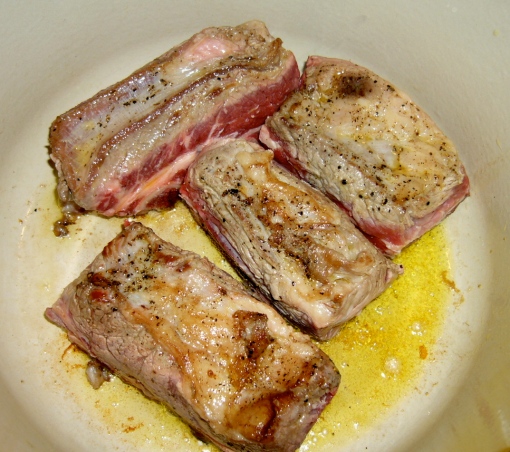It’s hard to believe but it’s already mid-November! Most of the farmers’ markets have wrapped up for the year and many of us have put away our grilling equipment. However, there’s no need to despair that summer is over. It’s now time for one of easiest and most delicious types of cooking: Braising!
There are a number of reasons to love braising:
It’s Cost Effective: Cooking inexpensive cuts of meat low-and-slow transforms them into meal that is tender and succulent. For less than $8.00, a pork shoulder can feed up to six people. As for equipment, all you’ll need is a pot with a heavy lid, a stovetop and an oven and you’re good to go.
It’s Easy: Once the initial prep work is done (which usually involves little more than some simple chopping and searing), the braise goes into the oven and does its thing. You can sit back, enjoy a glass of wine and a few hours later dinner will be ready.
It’s Delicious: The results achieved from low-and-slow cooking are always impressive. The meat becomes meltingly tender and the resulting juices can be reduced to make a silky, luxurious sauce.
It’s Versatile: The basic technique of braising (sear the meat, add aromatics and liquid, cover and cook on low heat) can be adapted to work with almost any kind of meat or vegetable. The finished product can usually be used in a number of ways, from taco fillings to pasta sauces.

Enameled cast iron pots are ideal for braising (left: Le Crueset risotto pot; right: Le Crueset 5.5 quart pot)
For more great braising ideas, check out my recipes for Braised Short Ribs, Steve’s Osso Bucco, Guinness Stew and Barolo-Braised Beef with Pappardelle.
Chinese Braised Pork
Serves 4 to 6
- A 1.2 kilogram / 2.6 lb (approximately) pork shoulder blade roast
- 3 Tablespoons neutral oil, such as canola or safflower
- 1 medium carrot, peeled and diced
- 2 stalks celery, diced
- 1 medium onion, diced
- 3 garlic cloves, chopped
- 2 points of a star anise (or more/less, to taste)
- 1 teaspoon red pepper flakes
- A 1” piece of ginger, peeled
- 2 Tablespoons hoisin sauce
- 4 cups chicken stock
- 3 Tablespoons Shaoxing Chinese rice wine or dry sherry
- ¾ cup soy sauce (preferably sodium-reduced)
- 2 Tablespoons rice vinegar
- 6 Tablespoons (packed) brown sugar
- Salt and pepper, to taste
- 2 teaspoons cornstarch + 2 teaspoons cold water
- Chopped green onions, for serving (optional)
- Preheat oven to 350 degrees Fahrenheit.
- Sprinkle the roast liberally with salt and pepper.
- In a large (5.5 quart) enameled cast iron pot or other ovenproof pot with a lid, heat the oil on medium-high.
- Add the roast and brown on each side, about three to four minutes per side. Remove the roast from the pot and set aside.
- Add the diced carrots, celery and onion to the pot. Reduce heat to medium and cook for two minutes.
- Add the chopped garlic, star anise points, red pepper flakes and ginger. Continue to cook until the vegetables are softened, about three to four more minutes.
- Stir in the hoisin sauce until thoroughly mixed in and cook for another minute.
- Pour in the chicken stock, shaoxing wine (or sherry), soy sauce and rice vinegar. Add the brown sugar and stir until dissolved.
- Bring the sauce to a boil and return the pork shoulder to the mixture.
- Cover tightly and place in the oven for one hour. After one hour, remove the star anise points if desired (it is quite strong). Return the pot for another hour.
- Check on the braise after the second hour. When done, it should be fork tender. Return to the oven for another 30 to 45 minutes, or until completely tender and the meat is easy to shred.
- Remove the pot from the oven and transfer to the stovetop. Carefully take the shoulder out of the liquid and set aside in a large bowl.
- Strain the remaining sauce through a fine mesh strainer into a saucepot. Bring the sauce to a boil and reduce for about 15 to 20 minutes.
- In a separate cup, combine 2 teaspoons cornstarch with 2 teaspoons cold water. Stir until the cornstarch is completely dissolved and free of lumps. Pour into the strained and reduced braising mixture.
- Continue to boil for another five minute until the sauce begins to thicken slightly and is a bit glossy. Season with salt and pepper to taste.
- To serve: Break off chunks of the pork shoulder with a fork. Pour the sauce liberally over the meat and garnish with green onions, if desired. It’s delicious over rice or noodles and accompanied by sautéed bok choy.
Note: The meat and sauce can be refrigerated overnight, making it easy to skim off any excess fat. The sauce will likely gel once cooled but will return to liquid once heated.
Bon Appétit and Enjoy!
Get updates from The Seasonal Gourmet on Facebook and Twitter. Join the conversation today!
Copyright Trish Coleman. Please contact the author to obtain permission for republication.












